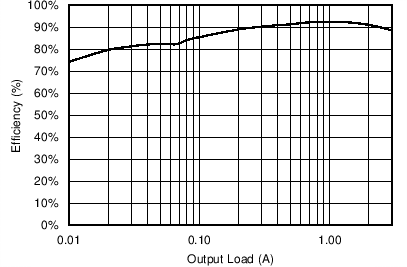SLVSCN0C june 2014 – may 2023 TPS65263
PRODUCTION DATA
- 1
- 1 Features
- 2 Applications
- 3 Description
- 4 Revision History
- 5 Device Comparison Table
- 6 Pin Configuration and Functions
- 7 Specifications
-
8 Detailed Description
- 8.1 Overview
- 8.2 Functional Block Diagram
- 8.3
Feature Description
- 8.3.1 Adjusting the Output Voltage
- 8.3.2 Enable and Adjusting UVLO
- 8.3.3 Soft-Start Time
- 8.3.4 Power-Up Sequencing
- 8.3.5 V7V Low Dropout Regulator and Bootstrap
- 8.3.6 Out-of-Phase Operation
- 8.3.7 Output Overvoltage Protection (OVP)
- 8.3.8 Pulse Skipping Mode (PSM)
- 8.3.9 Slope Compensation
- 8.3.10 Overcurrent Protection
- 8.3.11 Power Good
- 8.3.12 Thermal Shutdown
- 8.4 Device Functional Modes
- 8.5
Register Maps
- 8.5.1 Register Description
- 8.5.2 VOUT1_SEL: Vout1 Voltage Selection Register (offset = 0x00H)
- 8.5.3 VOUT2_SEL: Vout2 Voltage Selection Register (offset = 0x01H)
- 8.5.4 VOUT3_SEL: Vout3 Voltage Selection Register (offset = 0x02H)
- 8.5.5 VOUT1_COM: Buck1 Command Register (offset = 0x03H)
- 8.5.6 VOUT2_COM: Buck2 Command Register (offset = 0x04H)
- 8.5.7 VOUT3_COM: Buck3 Command Register (offset = 0x05H)
- 8.5.8 SYS_STATUS: System Status Register (offset = 0x06H)
- 9 Application and Implementation
- 10Device and Documentation Support
- 11Mechanical, Packaging, and Orderable Information
3 Description
The TPS65263 incorporates triple synchronous buck converters with 4.5- to 18-V wide input voltage range that encompassed most intermediate bus voltage operating off 5-, 9-, 12-, or 15-V power bus or battery. The converter, with constant frequency peak current mode, is designed to simplify its application while giving designers options to optimize the system according to targeted applications. The device operates in 600 kHz with 180° out-of-phase between buck1 and buck2, buck3 (buck2 and buck3 run in phase).
The initial startup voltage of each buck can be set with external feedback resistors. The output voltage of each buck can be dynamically scaled from 0.68 to 1.95 V in 10-mV step with I2C controlled 7 bits VID. The VID voltage transition slew rate is programmable with 3-bits control through I2C bus to optimize overshoot/undershoot during VID voltage transition.
Each buck in TPS65263 can be I2C controlled for enabling/disabling output voltage, setting the pulse skipping mode (PSM) or force continuous current mode (FCC) at light load condition and reading the power good status, overcurrent warning and die temperature warning.
The TPS65263 features overvoltage, overcurrent, short-circuit, and overtemperature protection.
| PART NUMBER | PACKAGE | BODY SIZE (NOM) |
|---|---|---|
| TPS65263 | RHB (VQFN, 32) | 5.00 mm × 5.00 mm |
 Typical Application
Typical Application